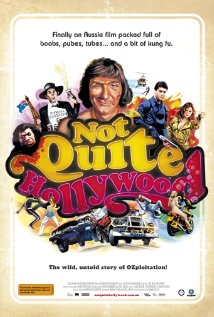
NOT QUITE HOLLYWOOD: THE WILD UNTOLD STORY OF OZPLOITATION!
Australia, 2009, 103 minutes, Colour.
Directed by Mark Hartley.
This is an intriguing documentary for anyone interested in the Australian film industry. But, it is not an analysis of mainstream Australian filmmaking. Rather, it is an exploration of the exploitation films, especially in the 1970s and into the 1980s, what has come to be Ozploitation.
It presents itself with several chapter headings, focusing, especially, on sexual themes as well as horror themes. The film tantalises its audience in the first chapters by focusing on sex. We are reminded of the Alvin Purple films, the exploitation films of John Lamond. As with the succeeding chapters, there is an ample selection of clips from many of the films. There are also many talking heads, producers, actors, directors and social observers.
During the 1970s a great number of horror films were produced. Many of them were made by Antony I. Ginnaen, reviled by many as an exploiter (especially by Bob Ellis and Phillip Adams during this film), making contracts with overseas stars to come to Australia, films which were considered mid-Pacific, angering the screen unions. A number of prominent directors made some of these films including Richard Franklin and Simon Wincer. Once again, there are many clips from these films, including Richard Franklin’s Patrick, which was later re-made by director, Mark Hartley.
The film takes back to the early 1970s with Tim Burstal’s Stork, with words from playwright, David Williamson. The Barry McKenzie? stories also feature with Dame Edna Everage and comments from Barry Crocker and Bruce Beresford. Interesting scenes from the making of Mad Dog Morgan, with the bizarre behaviour of the star, Dennis Hopper, and comments from producer Jeremy Thomas and director Philippe Laura. There are the martial arts actioners, even with comment from George Lazenby reflecting on his career. And the bikie film, Stone, with its star and director, Sandy Harbutt.
Another interesting feature of the film is that one of the major talking heads is Quentin Tarantino, drawing on his early experience, working in a video store watching all the horror films he could, which influenced his unique style. Tarantino must love Australia because he cast himself as an Australian (with an atrocious accent) in his Django Unchained.
Among the many talking heads are Alan Hopgood, Norman Yemm, producer Alan Finney, Graeme Blundell (Alvin Purple), producer David Hannay, John- Michael Howson, Stacy Keech and Jamie Lee Curtis reflecting on Road Games, George Miller on mad Max, Rod Taylor, Directors John Lamont, Ted Kotcheff (Wake in Fright) photographers Donald Mc Alpine, Russell Boyd and Vincent Monton top, Russell Mulcahy, Fred Schepisi, Sigrid Thornton and, amongst the contemporary directors with a flair for horror, Jamie Blanks, Wolf Creek’s Greg Mc Lean, and the Saw series James Wong and Leigh Whannell.
This is an opportunity to revisit the period, learn about some of the films, about people associated with them reflecting on the films, and, of course, see many of the clips.